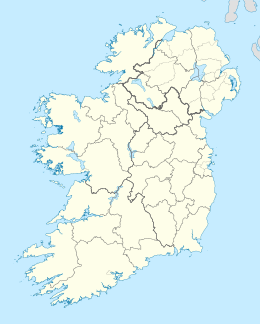Innisfallen
Native name: Inis Faithlinn | |
|---|---|
 The ruins of Innisfallen Abbey seen from the lake | |
 Innisfallen | |
| Geography | |
| Location | Lough Leane |
| Coordinates | 52°02′45″N 9°33′13″W / 52.04583°N 9.55361°WCoordinates: 52°02′45″N 9°33′13″W / 52.04583°N 9.55361°W |
| Area | 21 acres (8.5 ha) |
| Administration | |
| Province | Munster |
| County | Kerry |
| Demographics | |
| Population | 0 |
Innisfallen (/ˌɪnɪsˈfælən/ IN-iss-FAL-ən)[1] or Inishfallen (from Irish: Inis Faithlinn [ˈɪnʲɪʃ ˈfah(ə)lʲɪn̠ʲ],[1] meaning 'Faithlinn's island') is an island in Lough Leane; one of the three Lakes of Killarney in County Kerry, Ireland.
Innisfallen is home to the ruins of Innisfallen Abbey, one of the most impressive archaeological remains dating from the early Christian period found in the Killarney National Park. The monastery was founded in 640 by Saint Finian[a] and was occupied for approximately 950 years.

Geography[]
The island is situated about the midway in Lough Leane, County Kerry.[4] The island is some 21 acres (85,000 m2) in area, mostly wooded, with undulating hills and many slopes.[5]
Access[]
It is possible for tourists to visit the island during the summer months, with boats leaving from Ross Castle throughout the day.
History[]

Innisfallen is home to the ruins of Innisfallen Abbey, one of the most impressive archaeological remains dating from the early Christian period found in the Killarney National Park. The monastery was founded in 640 by Saint Finan and was occupied for approximately 950 years. Over a period of about 300 of these, the monks wrote the Annals of Innisfallen, which chronicle the early history of Ireland as it was known to the monks. The monks were dispossessed of the abbey on 18 August 1594, by Elizabeth I.[citation needed]
The location of the monastery on the island is thought to have given rise to the name Lough Leane (Irish Loch Léin), which in English means "Lake of Learning". According to tradition the Irish High King Brian Boru received his education at Innisfallen under Maelsuthain O'Carroll.[6] Maelsuthain has been credited as the possible originator of the Annals.[6]
Structures[]
While the abbey dates back to the seventh century, the oldest extant structure, dated to the tenth century, is the western two-thirds of the abbey church. The remainder of the church and the main abbey complex were constructed in the thirteenth century. A third structure, an oratory with a Hiberno-Romanesque doorway, dates from the twelfth century.[7]
Literature[]
The island is the subject of the melody Innisfallen, the Island — Sweet Innisfallen by T. Moore, of with the first verse is:[4]
Sweet Innisfallen, fare thee well !
May calm and sunshine long be thine ;
How fair thou art let others tell,
To feel how fair shall long be mine.
See also[]
- List of abbeys and priories in the Republic of Ireland (County Kerry)
Notes[]
- ^ John Healy (1890) disputed the common belief that the church and abbey on Innisfallen island in Lough Leane was founded by Saint Finian Lobhar (Finan the Leper), which he considered improbable.[2] Saint Finan Cam, on the other hand, was born in County Kerry of an old family of Kerry, and spent most of his life in the west of Kerry, where many places bear his name.[3]
References[]
- ^ Jump up to: a b "Inis Faithlinn/Innisfallen". Logainm.ie.
- ^ Healy 1890, p. 439.
- ^ Healy 1890, p. 440.
- ^ Jump up to: a b Killarney (1849), p. 36.
- ^ Killarney (1849), p. 37.
- ^ Jump up to: a b O'Connor 1910.
- ^ Okasha & Forsyth 2001, p. 160.
Sources[]
- Description of the lakes of Killarney and the surrounding scenery. London: W. H. Smith & Son. 1849. OCLC 935098203. OL 23463670M.
- Healy, John (1890), Insula Sanctorum Et Doctorum, BoD – Books on Demand, ISBN 978-3-7523-3423-4
 This article incorporates text from this source, which is in the public domain.
This article incorporates text from this source, which is in the public domain. - O'Connor, Denis (1910). Diocese of Kerry and Aghadoe. The Catholic Encyclopedia. 8. New York: Robert Appleton Company. Retrieved 19 May 2010.
- Okasha, Elisabeth; Forsyth, Katherine (2001), Early Christian inscriptions of Munster: a corpus of the inscribed stones, Cork University Press
- Archaeological sites in County Kerry
- Islands of County Kerry
- Lake islands of Ireland
- Uninhabited islands of Ireland
- Former populated places in Ireland
- Religion in County Kerry
- County Kerry geography stubs
- Ireland archaeology stubs

